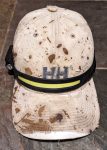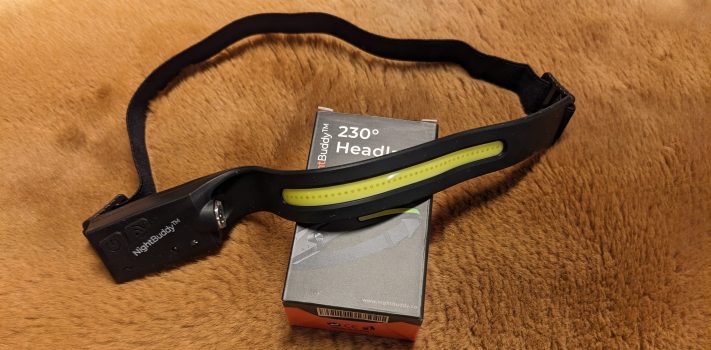The NightBuddy 230° LED headlamp uses an LED lightbar that bends around the forehead at the front of the lamp. This provides an even flood of illumination that is excellent for working outdoors in the dark. It is reliable, lightweight, compact, rechargeable, water-resistant, and easy to use.
Battery life is somewhat less than advertised. I must also admit to being somewhat disgruntled by the fact that it is made in China. I feel that NightBuddy Customer Support was not 100% forthright when I inquired about its place of manufacture.
The NightBuddy cost $34.95 from www.nightbuddy.com at the time of this writing.
Background
I have a day job. As a result, walking the dog, stoking the outside wood boiler, clearing snow, and a host of other tasks around the property often take place before sunrise or after sunset, especially during the long dark hours of winter. I generally perform these tasks with the assistance of a headlamp.
I recently ran across the NightBuddy. I thought it might have some advantages over the Olight Array that I typically use for my nocturnal outdoor work. I contacted NightBuddy Customer Service. After asking some questions about the country of origin of the headlamp, I requested a sample for testing and evaluation. After some discussion, they were kind enough to agree. Before long, a package containing 2 NightBuddy headlamps arrived via USPS Ground Advantage.
Where Is It Made?
When I opened the package, I was more than a little disgruntled and embarrassed to note that the package boxes containing the headlamps were clearly imprinted with the words, “Made in China.”
I was disgruntled, because my initial message to NightBuddy Customer Service had been to pose the question: “Where is the Night Buddy made?’
The answer I received was, “Our products are handmade at local workshops in 5 different countries. Your order may be shipped from our warehouses in the USA, Thailand, Tibet, China or India. Shipping directly from those Countries is the most efficient and eco-friendly way.”
I felt that answer was somewhat ambiguous, so I asked for more detail, writing, “I am specifically interested in the 230 degree LED Headlamp. Is it made in all 5 countries, or just some of them?”
The answer I received was, “All our parts are from different suppliers depending on where the order is being delivered to. So where ever the order is heading, is then made and sent from.” I interpreted that to mean that the headlamp is manufactured in the 1 of the 5 countries that is closest to the country of delivery. Since the USA is the named country of origin that is closest to the USA, I believed that the headlamp I tested would be made in the USA.
I was embarrassed because SurvivalBlog Senior Editor James Wesley, Rawles (JWR) specifically warned me that the product was probably made in China. I replied that I had corresponded with customer service, and that they had indicated that the product is handmade at workshops in the USA, Thailand, Tibet, China, or India depending on where they are to be shipped. Poor Jim was probably shaking his head and wondering if I was next going to buy the Brooklyn Bridge.
First Impressions
Each of the 2 headlamps that I received was packaged in a 3.88 x 2.38 x 1.63 inch box. The headlamps are charged using an included USB-C charging cable (no charger was included).
The simple directions for operating the lamps are printed on the sides of the boxes in extremely fine print. I can read the directions okay with my bifocals but not without them:
Plug theNightBuddy into a USB port or USB charger to give it some juice.
Adjust the headband for a perfect fit. The NightBuddy should feel secure and not wobble on your head.
Once charged, press the power button to switch between 5 different light modes.
To activate the wave sensor, press the wave sensor switch and wave hand next to the sensor.
To enable the flash function, press the power button then press it a second time quickly after and hold until the flash function turns on.
Press the power button to cycle through the light modes until the light turns off completely. Don’t forget to recharge when not in use.
As the directions indicate, the headlamps operate in 5 different modes: high flood, low flood, red flood, spotlight, and strobe.
The 3 flood light modes do an excellent job of illuminating the entire field of vision, including the peripheral vision. This is especially helpful in the red flood mode, during which the peripheral vision can be more acute than the center vision.
I usually wear a headlamp over a baseball cap. The spotlight is located on the battery pack on the right side of the headlamp. This causes the brim of a baseball cap to cast a significant shadow to the left of the user.
A motion-activated sensor can also be engaged to allow the headlamp to be turned on and off by moving one’s right hand past the right side of the unit as if one is shooing away a fly.
Daily Use
I charged the battery fully, and then began to use the lamp for my daily nocturnal tasks.
 I quickly discovered that the high flood was brighter than I usually needed, so the low flood became my standard setting. The red flood was handy for use when I wanted to preserve my night vision. The spotlight was useful when I wanted to focus on something beyond the reach of the flood. I did not find the strobe setting to be useful. I found operating the headlamp with the power button to be simple enough that the motion activated sensor did not seem to be particularly useful to me.
I quickly discovered that the high flood was brighter than I usually needed, so the low flood became my standard setting. The red flood was handy for use when I wanted to preserve my night vision. The spotlight was useful when I wanted to focus on something beyond the reach of the flood. I did not find the strobe setting to be useful. I found operating the headlamp with the power button to be simple enough that the motion activated sensor did not seem to be particularly useful to me.
I found the light weight and the red flood setting of the NightBuddy to be its chief advantages over the Olight Array that I typically used. But after just a couple of weeks of regular use, the battery on the NightBuddy was expended. This was about half as long as the battery pack usually lasts for my typical level of usage for the Olight Array.
 The light from the NightBuddy naturally pointed in the right direction when it was worn in conjunction with a ball cap. The light pattern was not quite as effective when worn in conjunction with a jeep cap, and was harder to adjust under those conditions than the light of the Olight Array. The straps of the NightBuddy also tend to loosen more quickly over time than the straps of the Olight Array. I never had a problem with the NightBuddy falling off, but the straps worked loose enough at times that it made me uneasy.
The light from the NightBuddy naturally pointed in the right direction when it was worn in conjunction with a ball cap. The light pattern was not quite as effective when worn in conjunction with a jeep cap, and was harder to adjust under those conditions than the light of the Olight Array. The straps of the NightBuddy also tend to loosen more quickly over time than the straps of the Olight Array. I never had a problem with the NightBuddy falling off, but the straps worked loose enough at times that it made me uneasy.
Since NightBuddy was kind enough to provide me with 2 headlamps, I passed one along to my daughter, “Rivka” since she does quite a bit of dog walking in the dark. She was quite favorably impressed with the NightBuddy, and it has permanently replaced her previous headlamp in daily use.
Battery Life Testing
After fully recharging the battery, I turned the headlamp on at the high flood setting. About 4 hours later the battery was dead.
I fully recharged the battery again and turned the headlamp on the low flood setting. About 6 hours later the battery was dead.
Next, I fully recharged the battery and turned the headlamp on the red flood setting. Less than 5 hours later the battery was dead.
Finally, I fully recharged the battery and turned on the spotlight. About 7.5 hours later the battery was dead.
I did not test for battery life in strobe mode because I found the strobe to be irritating, and do not believe the setting to be useful.
The NightBuddy headlamp was unable to achieve the advertised 8 hours of battery life regardless of the mode in which it was operated. This testing was completed indoors, with an average temperature of 68 degrees Fahrenheit. Battery life will typically be shorter under cold weather conditions.
Conclusions
The NightBuddy 230 Headlamp is lightweight, compact, durable, reliable, and easy to operate. It has 4 very useful light settings and 1 that is less useful. Battery life is less than could be desired, ranging from about 4 to about 7.5 hours depending on setting. It is manufactured in China.
 I like the pattern of light that it puts out on the low flood setting better than the pattern of light that is put out by the Olight Array that I previously used. I am also quite impressed with its red flood setting. The NightBuddy has become my go to headlamp for daily use. Its lighter weight would also be a benefit during field use under conditions where battery life would be a secondary consideration.
I like the pattern of light that it puts out on the low flood setting better than the pattern of light that is put out by the Olight Array that I previously used. I am also quite impressed with its red flood setting. The NightBuddy has become my go to headlamp for daily use. Its lighter weight would also be a benefit during field use under conditions where battery life would be a secondary consideration.
Disclaimer
NightBuddy was kind enough to provide me with two samples of their 230 Degree LED Headlamp for testing and evaluation. I tried not to let their kindness interfere with the objectivity of my review, and I believe that I have succeeded. I did not receive any other financial or other inducement to mention any vendor, product, or service in this article.










